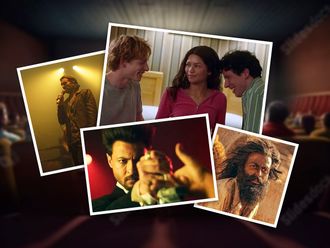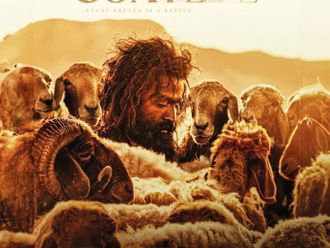Helvetica, a film about the life of a typeface so familiar to us, demands we take a second look at how we see words everyday. It will be screened during the Dubai International Film Festival (DIFF) this week.
You see it on ubiquitous street signs, public transportation systems, opening-hour notices, kiosks, garbage trucks, newspaper vending boxes, storefronts, billboard advertisements, subway stops and platforms. Even 'push' or 'pull' signs on a door.
Companies from Nestlé and American Airlines to Jeep, Microsoft, Toyota, Gap and Panasonic use it.
Why, it's the choice of even Nasa and the UN.
Wondering what it is? It's Helvetica, the typeface that interacts with us everyday, everywhere. In fact, it celebrates its 50th birthday this year.
Helvetica is the choice of signboard designers to inform us which way to go and what to buy; it imposes restrictions, allows us to read the latest headlines or tries to sell us an exciting holiday package. It serves us warning - in 'don't litter' and 'danger' ('high voltage') signs. It's the choice of font for many government forms.
So is it any wonder that Helvetica inspired Gary Hustwit, American producer and director, to turn it into an independent, feature-length film?
In a statement, exclusive to Friday in the Middle East, Hustwit recalled walking around New York City, listening to his iPod, when he suddenly saw the whole film in his head.
"I saw Helvetica everywhere, and watched people interacting with it, but not really thinking about it. A city of millions of people just going about their lives, letting a typeface tell them which direction their subway train was headed, where they could park, where the bathroom was, how much to pay for a hot dog ... I felt like I'd stumbled onto a secret language,'' he says.
Helvetica, the film, opens with a person assembling cast metal letters and binding them tightly. He then presses the letters onto a coating of ink, and proceeds to make an impression on paper using a roller. Then he flips it.
On the obverse is the title of the film - Helvetica, a film about the life of a typeface in every are of our life.
Typeface and global visual culture
"It was never a problem finding Helvetica in the cities we toured,'' says Hustwit, who shot his directorial debut film in high-definition on location in the US, England, the Netherlands, Germany, Switzerland, France and Belgium.
The film crew, when driving through Berlin, spotted a man climbing up the side of a World Cup banner, fixing six-foot Helvetica letters on it.
"The challenge was trying to find the most interesting usage. We dodged cars and trucks during weeks of street shooting. On so many shots in the film, we just plain got lucky,'' he says.
The Museum of Modern Art (MOMA), New York, is currently hosting an exhibition titled '50 Years of Helvetica' (until March 31, 2008) where it presents posters, signage and other graphic material demonstrating the enduring beauty of this design classic.
Then there is Helvetica: Homage to a Typeface, a book by Lars Müller filled with colour images of Helvetica in use - from album covers and road signs to advertisements and product packaging. (He also features in the film.)
In comparison, the film explores Helvetica's interaction in urban spaces around the world. It speaks of the type trade and design world in modernism and postmodernism contexts.
"We wanted it (Helvetica) to be accessible to people who had little or no design experience, but still be entertaining for people who design for a living. I hope we were able to achieve that balance,'' says Hustwit.
The story is told through images of the typeface, interviews with designers and typographers, and footage of people interacting with it; and a compendium of Helvetica's history.
Hustwit wasn't prepared for the reaction the film crew received once the film premiered or the interest it garnered when screening in cities around the world.
"I went to 75 cities in the first six months of the screening tour. It's an incredible feeling to spend two years of your life and every cent you have making a film, and then be able to show it at sold-out events for great audiences in cities you've never been,'' he says.
In Dubai, the film will be screened at Traffic gallery during the Dubai International Film Festival (DIFF), which runs from December 9-16.
Helvetica - the typeface
One of the most esoteric subjects is typography or the craft of composing type and printing from it.
When Hustwit stumbled into book publishing in 1991, he was fascinated by type. He tried different typefaces for the books he was writing and publishing.
"I even designed a few bad grunge fonts in the mid '90s, which I gave away on the Web. I've been interested in graphic design and typography for over 20 years since I saw the first Macintosh computer in 1985,'' he says.
But it wasn't till he saw one of his "disgusting-looking'' fonts on CNN in 1996 that he realised the true power of typography. He was watching the news, and saw his font displayed across the backdrop behind the newscaster.
"My first thought was, 'Wow, 500,000 people just saw that, I wonder if I influenced them somehow?' But then I noticed the word they'd set in my scary, dirty, disgusting-looking font: 'welfare.' Why had CNN chosen to use a scary looking font for the word 'welfare'? Why not a clean, optimistic-looking font? And who made that decision in the first place?'' says Hustwit, who was an amateur graphic designer, designing concert posters and book covers.
In the film you see the typeface, Helvetica, in cast metal letters, drafts, dusty files with early sketches, specimen book, computerised versions and colourful signs.
At one point, the film exposes never-before viewed areas. Otmar Hoefar, director of font marketing, Linotype headquarters in Germany, takes you to the cellar, to the archives and pulls out a box file of Helvetica, which contains the early drawings.
The story of Helvetica is told in snatches of chronological tones, visual data and interviews. Ambient music fills the lacunae between storytelling and visuals.
"The list of interviewees consisted of people who had a historical connection with the typeface, or who had well-publicised opinions for or against it,'' says Hustwit.
The first half of the film takes the viewer to the former site of the Haas Type Foundry in Münchenstein, Switzerland, where Helvetica was "born'' or developed by Max Miedinger with Eduard Hoffmann in 1957 for Haas.
Originally, it was named Neue Haas Grotesk; it was a Swiss creation, characterised by its focus on clarity and attention to the white spaces between and within each letter.
To make the font internationally marketable, the name was changed to Helvetica. It was derived from Helvetia, the Latin name for Switzerland when Haas's German parent companies Stempel and Linotype began marketing the font internationally in 1961. (Linotype now owns Helvetica.)
At the time, Swiss design was enjoying inveterate popularity. As a result, Helvetica rose to ubiquity, and appeared everywhere from corporate logos to postage stamps. Then in 1984, Apple Macintosh included it as part of its list of typefaces.
Does Helvetica have a plot?
In 2005, Hustwit wanted to direct his own film. He knew he wanted it to be about graphic design and typography, but he wasn't sure how he would make a film about them.
Why Helvetica? More importantly, is typography a telegenic subject?
"Because it's all around us. I guess I just wondered, 'Why?' How did a typeface drawn by a little-known Swiss designer in 1957 become one of the most popular ways for us to communicate our words 50 years later?'' he says.
In the film, Hustwit answers these questions. He attempts to identify the repercussions of a typeface's popularity. And offers reasons for the globalisation of visual culture.
"Does a storefront today look the same in Minneapolis, Melbourne and Munich?'' he asks.
He also thought that looking at Helvetica's "career'' would be a good structural framework to look at the past 50 years of graphic design.
Helvetica documents interviews with illustrious and innovative designers and typographers. Hustwit interviews Alfred too, Eduard Hoffmann's son. In one section of the footage, Alfred takes a look at his father's notes of early trials.
"Here he is indicating corrections required - the 'Y' is too slim, 'A' is also too slim. My father had clear ideas how a typeface should look like,'' he said.
Hustwit found e-mail addresses of famous designers on the web.
"I asked if they'd like to be in a documentary about Helvetica. To my amazement, most of them said yes, and even pointed me in the direction of other designers,'' he says.
He couldn't believe that some of these designers had created more than 50 years of work that we see every day, but that no one had ever interviewed them on camera about what they do.
"But once I started filming the interviews, I realised that the film needed to be as much about these amazing artists as about a single typeface. I am very lucky to have found a group of such talented, humorous, and generous people,'' he says.
Through all these interviews you discover the cataclysmic factors responsible for change in the type trade and the design world. You find reasons behind Helvetica's popularity as well as its rejection because of it.
And you go along for the roller coaster ride through Helvetica's up and downs, especially its temporary demise during the 1970s and 1980s when graphic designers opted for more expressive fonts.
The highlights are the impassioned critiques of the perception of the font and its interpretation against the backdrop of urbanism.
Helvetica and the schism in design
Halfway through the movie, you realise Helvetica is not a neutral typeface. Its association elicits strong responses and foments even stronger reactions.
Hustwit didn't realise or expect such dissension or the divide between modernist and postmodernist design approaches.
The film flirts with the typeface's dealings with bureaucracy and capitalism through poignant voices. It plays with cultural connotations and artistic expressions.
Hustwit's documentary style is engaging, even heuristic. He hopes the film will make people, who aren't in the design trade, think twice about the words that surround them, and the effect that typefaces have on the way we process those words.
At the heart of the story is the truth that Helvetica impacts our urban life and the way we think and act. It is a film about the life of a typeface that demands we take a second look at how we see words every day.












